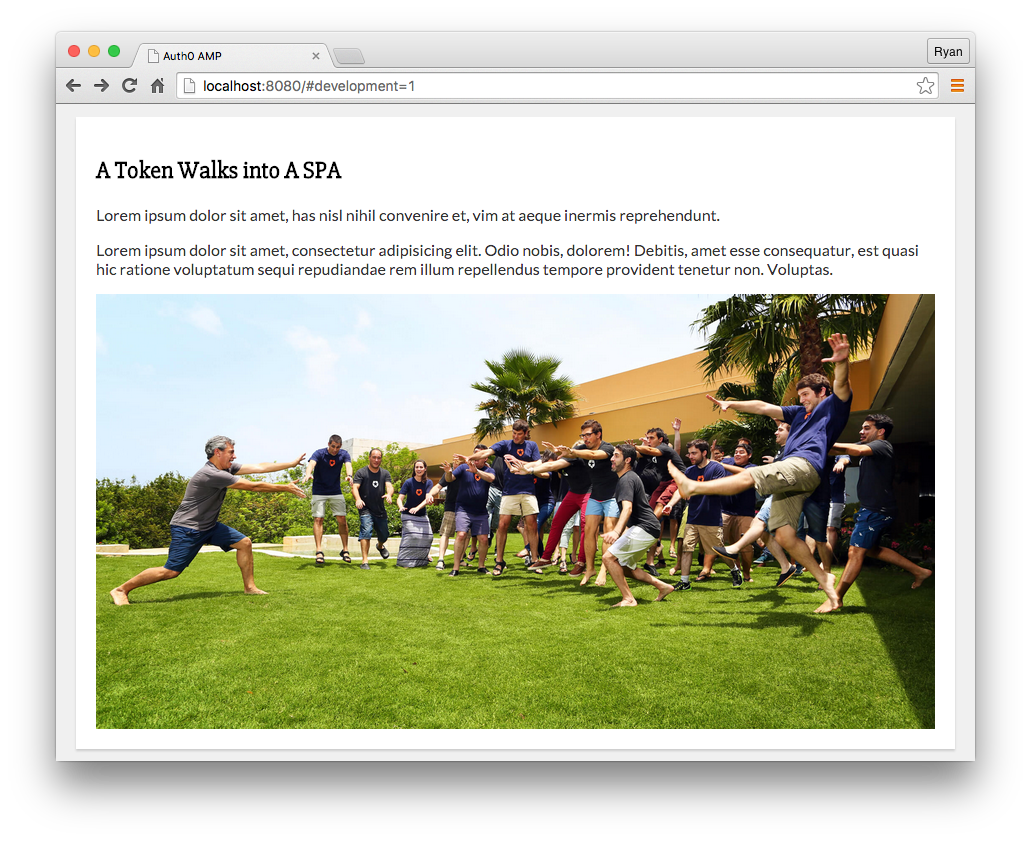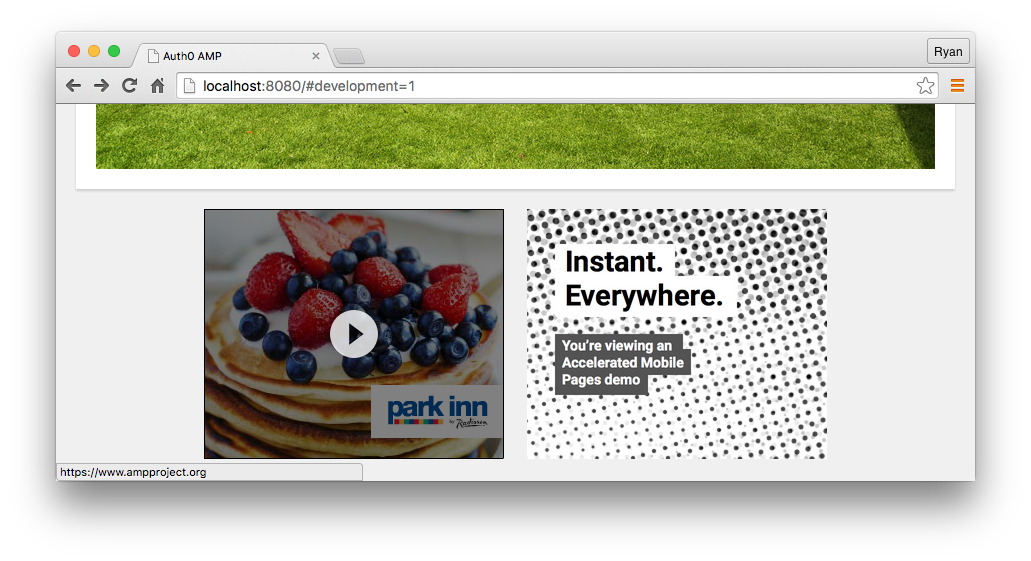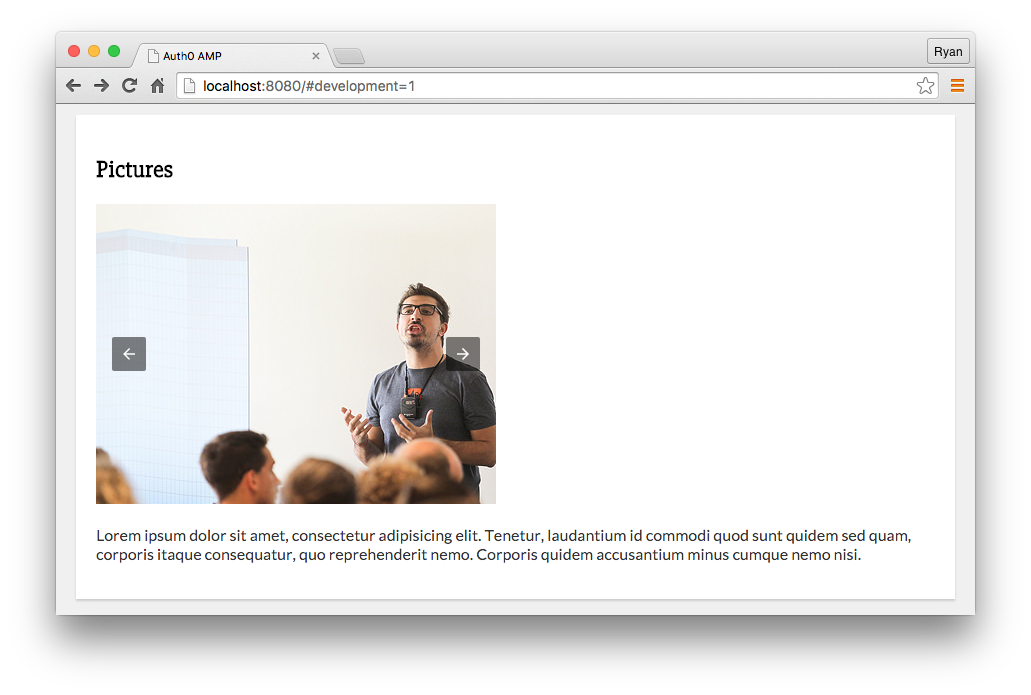TL;DR: Google has just released its Accelerated Mobile Pages (AMP) project, a library that provides custom components for making websites very fast. It takes a prescriptive approach that puts tight restrictions on developers but promises great speed gains. In this article, we take a look at some of AMP's features and build a demo page. Check out the repo to get the code for this tutorial and the AMP project for docs and further info. You can also check out the live demo.
It's easy for sites with rich content to run into performance issues on mobile devices. If you've ever browsed a content site that has a heavy footprint on desktop, chances are, the site wasn't the fastest you've ever visited when you viewed it on your phone or tablet.
Google's Accelerated Mobile Pages (AMP) project aims to solve these issues and make the user's browsing experience "instant", especially on resource-constrained mobile devices. The AMP project relies on existing standards and current technologies, so how exactly does it accomplish better performance? Largely by restricting what developers are able to incorporate into their sites. AMP also provides its own implementations for many commonly used features, which ensures that the features are optimized according to the AMP spec.
The AMP runtime JavaScript also takes care of a bunch of optimizations. These are things like loading only the content that is above the fold first and prioritizing or delaying image loading, among others.
Accelerated Mobile Pages (AMP) Limitations
Because AMP imposes many restrictions on us with the aim of making content sites really fast, it might be good to start off by going over what we can't do in it.
Here's a non-exhaustive list:
- No developer-written or third-party JavaScript
- No input elements of any kind, including standard
inputandtextarea - No external style sheets and only one
styletag in the document head - No inline styles
- Style rules must be at or below 50kb
That's quite a large set of restrictions, and we're just scratching the surface! While it might seem a bit too restrictive, there are good reasons for these limitations. Remember, AMP is all about content sites. There are many sites out there that force users to download heaps of JavaScript and CSS just for some simple animations or UI elements, which they could easily optimize or do without. Also, because most content sites simply display text and images (things like comment areas notwithstanding), the bet is that there isn't a huge need for input elements.
AMP Components
AMP comes with a small set of custom components to provide ways of implementing commonly needed features. It does so with custom elements that coordinate JavaScript execution (where applicable) and generally optimize performance. For example, the amp-img tag replaces the standard HTML img tag, and the reason is that amp-img can let the browser manage delaying or prioritizing image loading, depending on the position of the viewport and other factors. If an image is outside of the current view, the page can be sped up by not requiring it immediately.
“AMP comes with a small set of custom components to provide ways of implementing commonly needed features.”
Tweet This
AMP also provides extended components that can be requested from separate JS files to do even more. Here's a list of both the core and extended AMP components:
amp-img amp-audio amp-pixel amp-video amp-carousel amp-lightbox amp-ad amp-anim amp-iframe amp-instagram amp-twitter amp-youtube
The AMP Validator
We've gone over some of the restrictions that AMP puts on us to accomplish better performance, but how are these restrictions enforced? If we put disallowed markup or include our own scripts, the page will still render, but of course, we will be breaking the AMP rules. To help us see when we break the rules, AMP provides a validator that will let us know in the console what we've done wrong. To enable the validator, we simply need to browse our site with #development=1 appended to the end of the URL.
Let's Build an AMP Page
Let's see how we can use some of AMP's features by building our own site. We'll get a look at some of the core and extended features, but we won't be able to cover everything.
Required HTML
The first step is to create an AMP HTML document and include the AMP project JavaScript. AMP HTML documents are denoted with the tag <html ⚡>, but you can also use <html amp>.
<!doctype html> <html ⚡> <head> <meta charset="utf-8"> <title>Auth0 AMP</title> <link rel="canonical" href="index.html"> <meta name="viewport" content="width=device-width,initial-scale=1,minimum-scale=1,maximum-scale=1,user-scalable=no,minimal-ui"> <script async src="https://cdn.ampproject.org/v0.js"></script> <style>body {opacity: 0}</style><noscript><style>body {opacity: 1}</style></noscript> </head> <body> </body> </html>
It's important to note that everything we've included here is required for an AMP page. Why are we hiding the body element for JavaScript-enabled browsers? For optimization and UX. The AMP JavaScript needs to be responsible for rendering the page to ensure the best experience.
The canonical link is there to point to a non-AMP version of the site if one exists, but if there isn't one, we can just point the document to itself.
Styles
All styles must go in a style tag within the head of the document, which must contain the amp-custom attribute.
... <style amp-custom> /* Styles here */ </style>
We won't write out all of the styles for this example page here, but you can get them on GitHub if you'd like
Images
Next, let's put in a header image and title line.
... <header class="header-image"> <amp-img src="https://cdn.auth0.com/website/jobs/team_2.jpg" layout="responsive" width="2000" height="1035" alt="Team"> </amp-img> <div class="title-section"> <h1>A Token Walks Into a SPA</h1> <div class="author"> <amp-img src="https://www.gravatar.com/avatar/df6c864847fba9687d962cb80b482764??s=250" alt="Gonto" width="80" height="80"> </amp-img> <span>By: Gonto · October 12, 2015</span> </div> </div> </header> ...
We're using the core amp-img tag for all of our images. AMP needs to know about the height of each image (and all external media resources) before the page loads, so we provide these on the amp-img tag.
Lightbox
Next, let's put some content and a lightbox in place.
... <div class="content"> <article> <div class="section"> <h2>A Token Walks into A SPA</h2> <p> Lorem ipsum dolor sit amet, has nisl nihil convenire et, vim at aeque inermis reprehendunt. </p> <p> Lorem ipsum dolor sit amet, consectetur adipisicing elit. Odio nobis, dolorem! Debitis, amet esse consequatur, est quasi hic ratione voluptatum sequi repudiandae rem illum repellendus tempore provident tenetur non. Voluptas. </p> <amp-lightbox id="lightbox" class="lightbox" layout="nodisplay"> <div class="lightbox-content"> <amp-img src="https://cdn.auth0.com/website/jobs/team_2.jpg" width="2000" height="1035" layout="responsive"> </amp-img> <p> Lorem ipsum dolor sit amet, consectetur adipisicing elit. Tempore id iusto culpa labore, laborum, vitae perferendis praesentium incidunt necessitatibus quasi officia, dicta atque harum aliquam rerum inventore quam tempora fugit? </p> </div> </amp-lightbox> <amp-img id="main-image" src="https://cdn.auth0.com/website/jobs/team_2.jpg" srcset="https://cdn.auth0.com/website/jobs/team_2.jpg" placeholder width="2000" height="1035" layout="responsive" on="tap:lightbox"> </amp-img> </div> ...
This time, we're making use of amp-lightbox so that when a user clicks or taps on the image, a dark background is displayed behind it, and a caption shows up underneath. This is an external component, so we need to load it in separately. In the document head, let's add in the script reference:
... <script async custom-element="amp-lightbox" src="https://cdn.ampproject.org/v0/amp-lightbox-0.1.js"></script> ...
The lightbox is initially hidden with layout="nodisplay". Directly beneath the amp-lightbox, we have the same image coming through in an amp-image tag. It will be this image that is displayed on the screen initially, and then the lightbox image when the user clicks or taps it. We activate the lightbox with on="tap:lightbox" on the amp-img tag.
Advertisements
Many content sites keep the lights on with revenue generated by ads. Because ad placement providers rely on JavaScript to do their thing, AMP provides components for many of the popular ones. Currently supported providers include the following:
- A9
- AdReactor
- AdSense
- AdTech
- Doubleclick
We can place ads on our page much like we normally would, but this time, we use the amp-ad component.
... <div class="ad-container"> <amp-ad width="320" height="250" type="adsense" data-ad-client="ca-pub-8125901705757971" data-ad-slot="7783467241"> </amp-ad> <amp-ad width="320" height="250" type="doubleclick" data-slot="/4119129/mobile_ad_banner"> </amp-ad> </div> ...
We specify which provider we want on the type attribute and then set up some other attributes that are specific to that provider.
Videos
AMP gives us a component called amp-video for embedding generic video. We can also use the amp-youtube component to call on any YouTube video directly in the HTML. Let's pull in Gonto's ng-vegas talk video.
... <div class="section"> <h2>Video</h2> <p> Lorem ipsum dolor sit amet, has nisl nihil convenire et, vim at aeque inermis reprehendunt. </p> <amp-youtube video-id="pgFtp2LgwoE" layout="responsive" width="480" height="270"> </amp-youtube> </div> ...
We are able to specify the slug of the video we want on the video-id attribute.
Again, because this is an extended component, we need to bring in the AMP JavaScript for it. Let's load that in the head.
... <script async custom-element="amp-youtube" src="https://cdn.ampproject.org/v0/amp-youtube-0.1.js"></script> ...
Carousels
The final extended component that we'll see is amp-carousel for creating a simple and fast image rotator.
... <div class="section"> <h2>Pictures</h2> <amp-carousel id="main-carousel" width="400" height="300" type="slides"> <amp-img src="https://www.jsconfar.com/static/images/speakers/workshop-gonto.jpeg" width="400" height="400"> </amp-img> <amp-img src="https://c2.staticflickr.com/6/5758/20330662003_d444cd54d0.jpg" width="500" height="333"> </amp-img> <amp-img src="http://i.ytimg.com/vi/fWar75R1NGo/hqdefault.jpg" width="480" height="360"> </amp-img> </amp-carousel> <p> Lorem ipsum dolor sit amet, consectetur adipisicing elit. Tenetur, laudantium id commodi quod sunt quidem sed quam, corporis itaque consequatur, quo reprehenderit nemo. Corporis quidem accusantium minus cumque nemo nisi. </p> </div> ...
The carousel works by wrapping amp-img tags within an amp-carousel tag. After that, everything is pretty much the same. We'll also need the JavaScript for this component.
... <script async custom-element="amp-carousel" src="https://cdn.ampproject.org/v0/amp-carousel-0.1.js"></script> ...
The carousel comes with some default arrows to move left and right, but what if we wanted to put our own in? These arrows are SVG elements, and we can easily change the SVG up with something of our own with some CSS.
An example of the override from the AMP project docs:
.amp-carousel-button-prev { left: 5%; background-image: url('data:image/svg+xml;utf8,<svg xmlns="http://www.w3.org/2000/svg" width="18" height="18" viewBox="0 0 18 18"><path d="M11.56 5.56L10.5 4.5 6 9l4.5 4.5 1.06-1.06L8.12 9z" fill="#fff" /></svg>'); }
Again, we haven't included the styles for this sample page above, but they are included with the tutorial repo. You can also see the completed example by viewing the live demo.
Aside: Using Auth0 with your AMP Pages is Easy
Even content sites often require authentication. As was mentioned, we can't put input elements in an AMP document, nor can we use any custom JavaScript. Because of this, it will be necessary to have a login page or box that redirects to an AMP document that is content only.
This can be done in less than 10 minutes using Auth0's hosted login box. For example, if your account name is samples, you can just link people to https://samples.auth0.com/login?client=BUIJSW9x60sIHBw8Kd9EmCbj8eDIFxDC&redirect_uri=YOUR_AMP_APP and replace the YOUR_AMP_APP_URL with the correct one. Once the user authenticated successfully, you'll get a JWT in your AMP app, with which you can do authenticated requests to your API :boom:. Check out an existing Login box here. Time to signup to your Auth0 account!
Wrapping Up
As we've seen, AMP puts a lot of restrictions on us and requires that we use special components for things like images, video, and ads. This is all for the sake of making sites faster, and the AMP project has stated that it has observed speed improvements of 15% to 85%. This would certainly be a welcome enhancement for end users of many content sites, especially mobile users. However, as developers, it could be said that AMP is just too limiting for us to use in our projects. Some have even expressed that a Google-specific way of writing the web is ultimately bad for it.
I think AMP is an interesting project that will work well in acheiving a faster browsing experience for users of content sites. While we should be writing efficient pages by dropping JavaScript that isn't needed, paying attention to how our scripts are loaded, and generally just be doing better house-keeping, it's becoming harder to do that with the modern web. For many, it's ultimately easier to follow a prescription for how to make sites faster than it is to be disciplined enough to follow best-practices. At the same time, there is a part of me that feels as if we should just do a better job of getting back to basics with our sites, which would solve a lot (albeit perhaps not all) of the issues that AMP is aiming to solve.
About the author

Ryan Chenkie
Developer
Ryan is a Google Developer Expert, the host of the Entrepreneurial Coder Podcast, the author of Securing Angular Applications, and an all-around fanatic about application security.View profile






